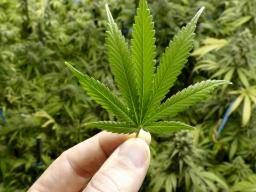- What is marijuana?
- Effects
- Risks
- Addiction
- Medical use
In 2017, 6 percent or about 1 in 16 high school seniors in the United States reported using marijuana (cannabis) every day. The number of 12th graders who think marijuana use is risky has halved in the last 20 years.
According to the 2013 National Survey on Drug Use and Health (NSDUH), 19.8 million, or 80.6 percent of people who used illicit drugs in the U.S. used marijuana in the month before being surveyed.
People can smoke marijuana, inhale it through vapor, brew it as a tea, apply it as a balm, or eat it in products, such as brownies or chocolate bars.
Some people use medical marijuana to treat chronic pain, muscle spasticity, anorexia, nausea, and sleep disturbances.
Medical marijuana refers to either whole marijuana or its ingredients, such as cannabidiol (CBD), which forms the base of a limited number of approved medications.
Medical marijuana is not subject to governmental standardization, making its ingredients and potency unknown. It is not legal in all states.
Fast facts on marijuana:
- The primary psychoactive ingredient in marijuana is delta-9-tetrahydro-cannabidinol (THC).
- Marijuana contains more than 120 compounds, which are likely to have different properties.
- The effects of recreational marijuana use include lightheadedness, a feeling of relaxation, increased appetite, and reduced blood pressure.
What is marijuana?

Marijuana comes from the Cannabis sativa plant.
Marijuana comes from the dried flowering tops, leaves, stems, and seeds of the Cannabis sativa (hemp) plant.
Humans have used marijuana for hundreds of years for fiber (hemp), seed oils, seed, medical treatment, and recreationally.
There is some evidence that marijuana or some of its components — such as CBD — may be useful for relieving severe pain, inflammation, nausea, and chronic conditions.
However, CBD is just one of at least 120 substances (cannabinoids) found in marijuana. People have many health concerns about the use of the drug.
Another primary component of marijuana is delta-9-tetrahydrocannabinol (THC).
THC is the key mind-altering (psychoactive) substance in marijuana. It acts on specific brain receptors, causing possible mood changes, depression, suicidal thinking, memory issues, and disruption to normal learning abilities. It may also produce dependency.
The compound is also known to stimulate appetite (informally known as “the munchies”) and induce a relaxed state, as well as other effects on sense of smell, hearing, and eyesight. THC can also cause fatigue. In some people, THC may reduce aggression.
Effects

Marijuana has many effects on the mind and body.
The effects of the 120-plus cannabinoids present in cannabis are mostly unknown, but the most potent psychoactive agent identified to date is THC.
When a person smokes cannabis, THC is quickly absorbed into the bloodstream, reaching the brain within minutes.
The body absorbs THC more slowly when it is eaten, delaying the onset of action for up to 2 hours and prolonging the duration of the effect.
THC and other cannabinoids in marijuana are similar to cannabinoids produced by the body. These natural cannabinoids act like neurotransmitters that send chemical messages between nerve cells (neurons) throughout the nervous system.
These neurotransmitters affect brain areas involved in memory, thinking, concentration, movement, coordination, sensory and time perception, as well as pleasure. The receptors that respond to these cannabinoids also react to THC, which can alter and disrupt normal brain function.
Some studies have shown that THC affects areas of the brain that control memory creation and attention.
It also disrupts other parts of the brain, adversely affecting balance, posture, coordination, and reaction time. This can make it unsafe for a person using marijuana to drive a car, operate heavy machinery, or engage in sports or other potentially dangerous physical activities.
THC also stimulates specific cannabinoid receptors that increase the release of dopamine, a neurotransmitter related to feelings of pleasure.
People use marijuana to achieve a feeling of elation (a high), giddiness, and relaxation. Marijuana also produces sensory perception changes; colors may seem brighter, music more vivid, and emotions more profound. Some people experience feelings of paranoia.
When people consume cannabis for recreational purposes, they might experience the following effects:
- changes in perception, due to a slight hallucinogenic effect that can create a distorted illusion of time and space
- mood changes, leading to euphoria, feelings of energy, or a state of relaxation
- higher heart rate
- reduction in blood pressure
- impairment of concentration and memory
- reduced psychomotor coordination
- nausea, even though some cannabinoids may help reduce nausea
- increase in appetite
- faster breathing
Depending on the length and amount of use, some traces of THC might still be present in a person’s urine for several months after they last used marijuana.
Risks
Below are some examples of findings that suggest or demonstrate some of the negative consequences of consuming cannabis:
- Impairment of judgment: A study in the BMJ found that a person is significantly more likely to crash their car if they drive within 3 hours of smoking marijuana.
- Reproductive issues: According to a review of animal studies, cannabis use might lead to sexual dysfunction.
- Immune response: According to one study, smoking marijuana could eventually suppress the body’s immune system, making the user more susceptible to certain types of cancer and infections.
- Psychosis: Research carried out on siblings suggested that long-term marijuana use could increase the risk of developing psychosis in young adults.
- Gum disease risk: One study indicated that smoking cannabis increases the risk of developing gum disease, regardless of whether the user smokes tobacco.
- Reduced brain function: Researchers found that regular cannabis users who started before they were 15 years old did not score as well on brain tests as their counterparts who began using cannabis later in life.
- Acute memory loss: A British study suggests that smokers of potent cannabis strains (skunk, for instance) may have a higher risk of acute memory loss.
- Changes in human DNA: A British study found compelling evidence that cannabis smoke damages human DNA in such a way that the user could become more susceptible to developing cancer.
- Testicular cancer: A 2015 review and meta-analysis of three earlier studies found that frequent or long-term marijuana use may increase the risk of developing testicular cancer, but more evidence is needed to confirm this.
Addiction

Marijuana may be addictive, and long-term use may cause various health problems.
Cannabis, like other pain relievers, can lead to dependence and addiction.
Over time, the severe, persistent overstimulation of the neurotransmitters that bind to cannabinoid receptors can cause changes in the brain that result in a marijuana use disorder or addiction.
According to the National Institute on Drug Abuse (NIDA), people who start using marijuana at a young age, and who are heavy users are more likely to develop a marijuana use disorder than some other users.
Cannabis withdrawal
Abrupt withdrawal from cannabis can be uncomfortable but not life-threatening.
Withdrawal begins on the second day after stopping and may persist for up to weeks.
Withdrawal symptoms include:
- anxiety
- irritability
- insomnia
- stomach pain
- decreased appetite
Sleep problems can potentially persist beyond that time frame.
The full extent of the long-term health risks of chronic cannabis use is currently unknown. There is no way to determine who will develop severe physical, psychological, or other unwanted reactions.
Synthetic marijuana
Drugs that do not have legal status, do not have FDA approval, or both cannot be guaranteed safe.
So-called synthetic marijuana, such as K2 or Spice, is not marijuana, although it contains some of the compounds found in marijuana.
Some people may try untested and illegal synthetic cannabinoids in the belief that they are legal. This can be dangerous and possibly fatal.
Legality
Cannabis and related products, such as CBD, are legal in some states but not in others. It is important to check your state laws before purchasing marijuana, cannabis, or their derivatives.
Medical use
Researchers have been looking into the possible benefits of cannabinoids for treating different health conditions.
These include autoimmune disease, inflammation, pain, seizure disorders, psychiatric disorders and substance use disorders, withdrawal, and dependence.
CBD in medicine
Many researchers are investigating the medicinal potential of cannabidiol (CBD), a cannabinoid found in marijuana that does not have psychoactive effects.
In June 2018, following a lengthy process of research and clinical trials, the FDA approved the use of CBD to treat two rare and severe types of epilepsy that do not respond well to other treatments.
The drug is called Epidiolex, and it is a medication that derives from marijuana. It is a purified cannabidiol that does not contain THC.
Some people believe that CBD might help relieve the pain and inflammation that occurs with fibromyalgia and arthritis, for example, and possibly for treating anxiety and addiction.
THC in medication
Some studies have demonstrated that THC shows some promise for the treatment of nausea and vomiting, but its adverse effects may limit its use.
It may have antiemetic qualities that make it helpful for people undergoing chemotherapy or other treatment where nausea can be a side effect.
THC may also decrease pain, inflammation, nausea, and muscle control problems, but as yet, no medications for these conditions have approval, and more evidence is necessary to confirm their safety and effectiveness.
Some clinical trials have shown that THC has mild-to-moderate pain-relieving effects, and might be useful for the treatment of headache pain.
Studies suggest that there are specific benefits of certain types of marijuana use, and the FDA will likely approve more types of marijuana for medical applications over time.
In addition to Epidiolex, three other drugs have received FDA approval: Marinol, Syndros, and Cesamet. These medications contain synthetic substances with a similar structure to THC. They are treatment options for some kinds of anorexia.
Other researchers are looking at the potential for marijuana extracts to target and kill cancer cells, in particular as a treatment alongside radiation therapy.
Results of a study published in July 2018 found no evidence that cannabis use can reduce pain or reduce the need for opioids in pain related to cancer. However, the use of cannabis was mostly illicit and did not focus on the use of specific cannabinoids.

Recent Comments